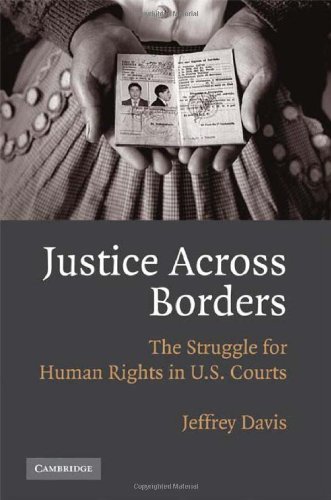Jeffrey Davis0521878179, 9780521878173, 9780511409875, 9780521702409
Table of contents :
Half-title……Page 3
Title……Page 5
Copyright……Page 6
Dedication……Page 7
Contents……Page 9
Acknowledgments……Page 13
THE REACH OF JUSTICE – ROMAGOZA V. GARCIA……Page 17
ORIGINS OF HUMAN RIGHTS LAW……Page 20
NUREMBERG – THE ROOTS OF JUDICIAL ENFORCEMENT……Page 23
Embracing Legal Accountability……Page 24
Nuremberg and National Sovereignty……Page 25
Head of State Immunity……Page 26
International Law and Human Rights……Page 28
Indirect and Private Liability……Page 29
ACCOUNTABILITY……Page 30
THE FIRST ATS HUMAN RIGHTS CASE – FILARTIGA V. PEÑA-IRALA……Page 33
TWO Competing Forces in the Struggle for Accountability: An Overview of the Issues Entangling ATS Litigation……Page 39
THE SUPREME COURT SPEAKS – SOSA V. ALVAREZ-MACHAIN (2004)……Page 40
History of the ATS……Page 42
Facilitating a Cause of Action……Page 43
The Law of Nations and Federal Common Law……Page 45
Allowing Causes of Action Under the ATS……Page 49
Separation of Powers……Page 51
Extraterritorial Jurisdiction……Page 53
STATE SOVEREIGNTY……Page 56
PRIVATE LIABILITY……Page 57
THEORETICAL FRAMEWORK……Page 58
THREE Human Rights Entrepreneurs: NGOs and the ATS Revolution……Page 60
THE ROLE OF NGOS IN HUMAN RIGHTS LITIGATION IN U.S. COURTS……Page 66
Starting the ATS Revolution……Page 68
Legal Innovation……Page 71
Private Defendants……Page 72
Command Responsibility……Page 74
Extending the Reach of the ATS to More Violations……Page 77
Universal Jurisdiction……Page 80
Addressing U.S. Foreign Policy……Page 82
Facilitating Impact in the Community and at Home……Page 84
SUCCESS OF NGOS IN ATS LITIGATION……Page 87
Relationships with Clients……Page 92
Human Rights Network……Page 95
Expertise……Page 100
Selectivity……Page 101
CONCLUSION……Page 103
CASES AGAINST THE UNITED STATES……Page 105
Sovereign Immunity in Cases against the U.S. Government……Page 107
The Political Question Doctrine……Page 115
State Secrets Defense……Page 118
Challenging the Doctrine of Deference……Page 119
The Military Commissions Act of 2006……Page 122
An Example of Executive Branch Intervention – Sarei v. Rio Tinto……Page 123
Standard for Reviewing Executive Branch Submission……Page 125
Before the Ninth Circuit Court of Appeals……Page 126
ANALYZING EXECUTIVE BRANCH INVOLVEMENT……Page 129
The Carter Administration……Page 134
The Reagan Administration……Page 136
The Clinton Administration……Page 138
The George W. Bush Administration……Page 140
A New Administration and a New Approach – The Unocal Case……Page 141
Motivations for the Bush Administration Approach……Page 143
Foreign Policy and the Political Question Doctrine……Page 145
Political Opposition to ATS Claims……Page 150
Ideological View on the Relative Power of the Executive and Judiciary……Page 151
Avoiding Reprisal Litigation……Page 156
Responding to Political Pressure……Page 158
Weight……Page 160
Immunity Cases……Page 169
Foreign Policy and Political Question Cases……Page 172
CONCLUSION……Page 176
FIVE No Safe Haven: Human Rights Cases Challenging Foreign Countries and Nationals……Page 180
EXTRATERRITORIAL JURISDICTION……Page 185
Forum Non Conveniens……Page 192
Exhaustion of Local Remedies……Page 197
SOVEREIGNTY……Page 199
Official Immunity……Page 203
Act of State Doctrine……Page 209
INTERNATIONAL COMITY……Page 212
STATUTE OF LIMITATIONS……Page 214
CONCLUSION……Page 217
SIX Holding Corporations Accountable for Human Rights Violations……Page 220
LIABILITY OF PRIVATE CORPORATIONS……Page 228
Suing Corporations for Violent Human Rights Violations……Page 240
Environmental and Other Nonviolent International Law Violations……Page 243
CONCLUSION……Page 249
SEVEN Sorting through the Ashes: Testing Findings and Predictions through Quantitative Analysis……Page 255
Human Rights NGOs……Page 256
Separation of Powers……Page 257
Violations of International Law……Page 262
State Sovereignty……Page 264
Territorial Jurisdiction……Page 265
Precedent……Page 266
Ideology……Page 269
Corporate Defendants……Page 273
DISTRICT COURT RESULTS……Page 274
COURT OF APPEALS RESULTS……Page 277
IMPLICATIONS……Page 280
EIGHT Impacts and Conclusion……Page 282
HUMAN RIGHTS NGOS AND THE STRUGGLE FOR HUMAN RIGHTS……Page 290
SEPARATION OF POWERS……Page 292
CASES INVOLVING FOREIGN NATIONS AND OFFICIALS……Page 295
CASES AGAINST CORPORATE DEFENDANTS……Page 296
On Individual Clients……Page 298
On the Broader Community……Page 303
On Corporations……Page 308
Creating a Historical Record……Page 310
Punishing Those Responsible……Page 312
CONCLUSION……Page 313
Index……Page 315

Reviews
There are no reviews yet.